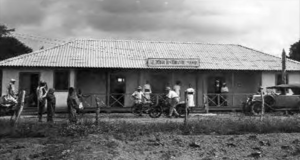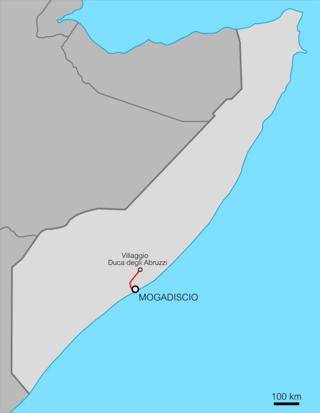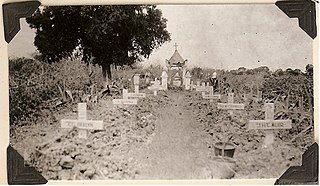
Villaggio Duca degli Abruzzi (often called "Villabruzzi" in Italian) was a village that was founded as an agricultural settlement in Italian Somalia.

Villaggio Duca degli Abruzzi (often called "Villabruzzi" in Italian) was a village that was founded as an agricultural settlement in Italian Somalia.
The Duca degli Abruzzi, a senior member of the Italian Royal Family, created the village in 1920 and raised funds for a number of development projects in this agricultural place, including roads, dams, schools, hospitals, a church and a mosque. He died in the village on 18 March 1933.
The Mogadishu-Villabruzzi Railway was initially built for the surrounding area of Mogadishu (Mogadiscio in Italian), after World War I in 1914. In the 1924, it was extended to Afgooye. In 1927, it was extended again by the Duca degli Abruzzi to the Shebelle River colonial village he was then developing. [1] The line, 114 km long, reached Villabruzzi in 1928. The original proposal was for the railway to go on from Villabruzzi to the Somali border with Ethiopia and into the Ogaden, but the Second Italo-Abyssinian War in 1936 stopped further construction.
From 1911 in the Shebeli river area the Italian government started to take the local farmers and resettle them in specific new villages in an attempt to improve the economy of Italian Somalia. The area around the "Villaggio Duca degli Abruzzi" was the most agriculturally developed of Somalia before World War II and had some food industries. [2]
In the Villaggio Duca degli Abruzzi the Italian colonists were experimenting with new cultivation techniques. In 1926, the colony comprised 16 villages, with some 3,000 Somali and 200 Italian inhabitants. It was commonly known as Villabruzzi.
In 1940, Villabruzzi had a population of 12,000, of whom nearly 3,000 were Italian Somalis, and enjoyed a notable level of development as a small manufacturing area.
WW2 hit the city and the agricultural production of the surrounding area hard. Currently the city has a new name: Jowhar.
Somalia, officially the Federal Republic of Somalia and formerly known as the Somali Democratic Republic, is a country located in the Horn of Africa. The country was an important centre for commerce with the rest of the ancient world, and according to most scholars, it is among the most probable locations of the fabled ancient Land of Punt. During the Middle Ages, several powerful Somali states and port towns dominated the regional trade, the Mogadishu Sultanate and Ajuran Sultanate both centered around the port town Mogadishu, but also the port towns of Barawe and Merca.

Transport in Somalia refers to the transportation networks and modes of transport in effect in Somalia. They include highways, airports and seaports, in addition to various forms of public and private vehicular, maritime and aerial transportation.

Italian Somaliland was a protectorate and later colony of the Kingdom of Italy in present-day Somalia. Ruled in the 19th century by the Somali Sultanates of Hobyo and Majeerteen in the north, and in the south by political entities such as the Hiraab Imamate and Geledi Sultanate.

Prince Luigi Amedeo, Duke of the Abruzzi, was an Italian mountaineer and explorer, briefly Infante of Spain as son of Amadeo I of Spain, member of the royal House of Savoy and cousin of the Italian King Victor Emmanuel III. He is known for his Arctic explorations and for his mountaineering expeditions, particularly to Mount Saint Elias and K2. He also served as an Italian admiral during World War I. He created Villaggio Duca degli Abruzzi in Italian Somalia during his last years of life.

Jowhar is the capital city of Hirshabelle state of Somalia. Jowhar is also the administrative capital of Middle Shabelle region of Somalia.

The Catholic Church in Somalia is part of the worldwide Catholic Church, under the spiritual leadership of the Pope in Rome.

Economic history of Somalia is related to the development of Somalia's economy in the last two centuries.

The Trust Territory of Somaliland, officially the "Trust Territory of Somaliland under Italian administration", was a United Nations Trust Territory situated in present-day Somalia. Its capital was Mogadishu and was administered by Italy from 1950 to 1960, following the dissolution of the former British Military Administration. It gained independence in 1960.

Italian Somalis are Somali-born citizens who are fully or partially of Italian descent, whose ancestors were Italians who emigrated to Somalia during the Italian diaspora, or Italian-born people in Somalia. Most of the Italians moved to Somalia during the Italian colonial period.

The Mogadiscio–Villabruzzi Railway is an historical railway system that ran through southern Somalia. It was constructed between 1914 and 1927 by the colonial authorities in Italian Somaliland. The railway connected the capital city Mogadishu with Afgooye, and subsequently with Villaggio Duca degli Abruzzi – usually called "Villabruzzi". The line was later dismantled by British troops during World War II. Plans for re-establishing the railway were made in the 1980s by the Siad Barre administration, but were aborted after the regime's collapse.

Railway transport in Somalia consisted of the erstwhile Mogadishu–Villabruzzi Railway and secondary tracks. The system was built during the 1910s by the authorities in Italian Somaliland. Its track gauge was 950 mm, a gauge favoured by the Italians in their colonies in the Horn of Africa and North Africa. The railway was dismantled in the 1940s by the British during their military occupation of Italian Somaliland, and was subsequently never rehabilitated.

Somalia Governorate was one of the six governorates of Italian East Africa. It was formed from the previously separate colony of Italian Somalia, enlarged by the Ogaden region of the conquered Ethiopian Empire following the Second Italo-Ethiopian War.

The Governor's Palace was the seat of the governor of Italian Somaliland, and then the administrator of the Trust Territory of Somaliland. It was built during the colonial period in the capital city of Mogadishu, situated in present-day southern Somalia. Used as municipality building of Mogadishu, it is one of the most popular government offices in Somalia. It was the first place where the Somali flag waved.

All railway stations in Italian Somaliland were served by the Mogadishu–Villabruzzi Railway of 114 kilometres (71 mi).

The Port of Merca also known as Merca Port, is the official seaport of Merca, situated in southeastern Somalia. It is classified as a jetty class port. It has a harbour as well as a pier which juts into the Somali Sea.

The Italian Somali Divisions were two divisions of colonial soldiers from Italian Somaliland that were formed as part of the Regio Esercito Royal Corps of Colonial Troops during the Second World War. In the Royal Corps of Colonial Troops, the units comprised the "101 Divisione Somala" and "102 Divisione Somala" and fought during the East African Campaign in 1941 before disbanding.

The Italian colonial railways started with the opening in 1888 of a short section of line in Italian Eritrea, and ended in 1943 with the loss of Italian Libya after the Allied offensive in North Africa and the destruction of the railways around Italian Tripoli. The colonial railways of the Kingdom of Italy reached 1,561 kilometres (970 mi) before WWII.

Vittorio di Africa was a small town in southern Italian Somalia, created by Italian colonists in the late 1920s near the southern Shebelle river.

Genale is a town founded by Italian colonists in the southeastern Lower Shebelle region of Italian Somalia. Currently it is called Janaale.

The Royal Banana Monopoly was a state-owned enterprise founded in Mogadishu in 1935, to transport and market bananas harvested in Italian Somalia throughout the rest of the Italian Empire, directly under the control of the Colonial Ministry. Even if the last transport of bananas to Italy happened in early 1940, it survived the first years of WW2 – and officially lasted until 1946.